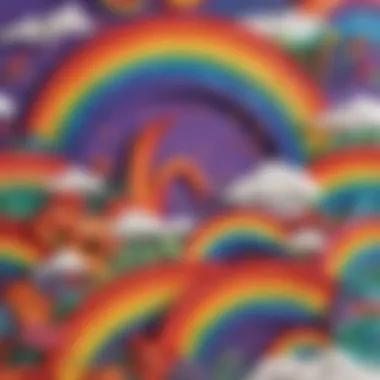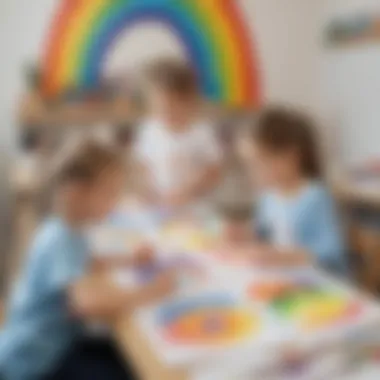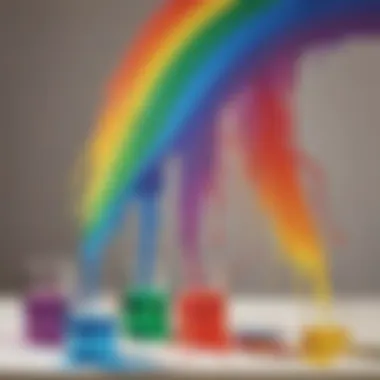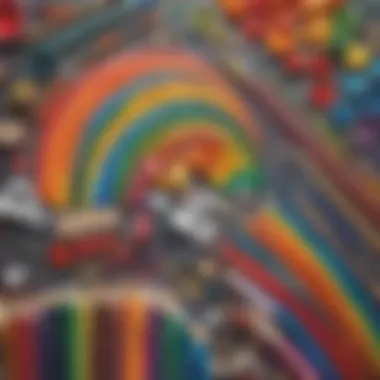Exploring Rainbow Crafts: Ignite Creativity and Learning


Intro
Rainbow crafts attract those who love creativity. They also foster problem-solving and critical thinking skills. For children, engaging in such crafts serves both art and science, forming a fulfilling learning experience. This article provides insight into the importance of rainbow crafts and how these activities can blend fun, creativity, science, and education by tapping into a child’s natural curiosity.
Science Fun Facts
Engaging in the world of rainbow crafts brings unique fun, but did you know it can open the door to fascinating scientific facts?
- Rainbows do not exist as physical arcs. They are optical phenomena. Our eyes create these colorful displays when light refracts and reflects through water droplets in the atmosphere.
- The colors in a rainbow are always the same. Everyone sees red, orange, yellow, green, blue, indigo, and violet! This consistency roots from the physics of light and water interaction.
Understanding these scientific principles can enrich the crafting experience, especially as children explore color mixing and light principles.
- Bowls of water and sunlight can create mini rainbows. Just fill a bowl with water and place it in sunlight. Position pure white paper on the other side to reflect vibrant color effects.
These quick bits remind us of science just waiting to be discovered through art!
Discover the Wonders of Science
Discovering through rainbow crafts is more than mere fun. Scientific concepts emerge with every brushstroke and paper fold. Children can explore colors and light behavior as they create, enriching their education.
- Exploring Various Scientific Concepts: Through crafts teachings on color theory can emerge. It leads to questions like: What happens when you mix red and blue? Each project allows kids to witness these concepts firsthand.
- Educational Videos and Animations: Resources from sites like Britannica can provide informative visuals about color theory, suitable case studies demonstrating iridescence, or the science behind spectrums.
- Interactive Learning Tools: Tools available from online platforms enhance engagement with fun activities. Using scientific probes to measure light can be adjusted and provide practical data.
- Real-Life Applications of Science: Investigating colors informs children about practical applications. Markets, clothes, and art have colors guiding choices. Ideally prepairing them for future learning dynamics.
As these principles unfold, children naturally develop analytical skills through exploration. This makes the hands-on experiences both meaningful and impactful once more.
Science Quiz Time
Learning doesn’t just happen quietly in the background. Here, children get active.
- Interactive Quizzes: Props like crafts can incorporate quizzes regarding colors and light. Set up questions, maybe a craft station built around asking these fun insights to them.
- Multiple Choice Questions can appear simple. One might engage on which colors mix with each other. Broad questions encourage self-testing.
- Brain Teasers and Puzzles: Simple puzzles engage mind and body through colorful tasks. Can they solve a mystery through integrated activities surrounding color clues?
- Learning Through Gamification: Game-like structures increasingly appeal to children. Crafting with time-limited challenges can push creative boundaries, ensuring learning sticks in enjoyable method.
Quizzes allow observation of understanding, measuring comprehension flexibly.
Science Experiment Showcase
True understanding has relational applications through experimentation. Practical experiences bleed into the inevitable creation found through rainbow crafts.
- Fun and Engaging Experiments: Construct mini-rainbows using simple methods. Strategic viewers pay observe how light reflects at angles and bends through water droplets.
- Step-by-Step Instructions are established publicly; clear which directions detailed supply needs crafted, too. This encourages independent thought development.
- Materials List: Essential materials might include: transparent glasses, water, prisms, or paper. Organizing supplies builds structure.
- Safety Tips and Precautions: While most crafts are safe, always remind kids with wastage of water or breaks by glass. Taking care makes delicious mess simply safe for budding creators.
Overall, rainbow crafts create an atmosphere where children explore learning through craft, effectively blending processes with purposeful education.
Prelude to Rainbow Crafts
Rainbow crafts are a beautiful melding of color, creativity, and curiosity. They provide numerous educational benefits, particularly for children between the ages of six and twelve. This age group is highly impressionable, exploring their understanding of the world through hands-on activities. The significance of engaging with rainbow crafts is multifaceted.
Such crafts are often more than mere art projects; they intertwine science and art seamlessly. Children learn to observe colors, recognize patterns, and explore symmetry through simple crafting activities. Furthermore, working with vibrant colors stimulates brain function. Colorful creations can lead to improved mood and motivation among young learners.
It's also important to consider the aspect of developmental skills. Through rainbow crafts, children can enhance motor skills, focus, and areas of cognitive development, including problem-solving. Working with tools and materials involves precision and learning cause-and-effect relationships in real time.


The Significance of Rainbow Crafts
The act of creating rainbow crafts serves several educational purposes. First, these crafts inspire exploration and discovery. Children get the chance to experiment with colors—understanding how different hues combine and interact. Through mixing, they may learn principles related to the color wheel and deviation.
Moreover, rainbow crafts develop fine motor skills. Actions like cutting, gluing, and painting enhance hand-eye coordination. These tasks require concentrated effort, which builds persistence and attention span.
Additionally, the use of colors can impact emotions and cognitive skills. Understanding how colors affect feelings adds a psychological element to this. Diverse colors may stimulate creativity, encouraging kids to express themselves freely. Here are a few significance points of rainbow crafts:
- Encourages engagement with both science and art.
- Aids fine motor skills development.
- Fosters problem-solving through creative processes.
- Enhances emotional expression via color.
Connection Between Art and Science
When discussing rainbow crafts, one cannot ignore the intrinsic relationship they share with the field of science. Art and science work together in a way where painting or crafting becomes a real-world application of scientific principles.
For instance, concepts like light refraction come into play when making use of different mediums. Textures and materials like watercolors illustrate how colors shift through layers. This highlights artistic creativity while also explaining essential physics phenomena.
- In addition to observing colors blending, children can learn about color theory, which is rooted in science.
- Art creation involves a variety of techniques that can spark interest in scientific exploration.
This connection reveals the dual benefits of engaging in rainbow crafts— they satisfy the creative urge and plant seeds for scientific curiosity. Blending these disciplines can lead to rich educational episodes that resonate with both fully hands-on learners and those interested in the beauty of both art and science.
The Science of Colors
The Science of Colors plays a crucial role in understanding rainbow crafts. Through these crafts, children engage with both artistic expression and scientific principles. This engagement nurtures their cognitive development. Learning colors and how they interact helps kids process visual information better. Additionally, discovering the science behind colors can lead to a deeper appreciation for the world around them.
Understanding the Color Spectrum
The color spectrum is a visual representation of all the colors visible to the human eye. It is often described in terms of wavelengths. Each color corresponds to a different wavelength of light. For example, red has a longer wavelength, while violet has a shorter one. Kids can explore this concept by understanding how light is broken down.
Colors do not exist in isolation. They influence one another and can change when combined. When children mix paints or use light filters, they can see how different colors interact. Such experimentation illustrates fundamental scientific concepts like color mixing, and it develops critical thinking skills. Theories of how colors mix broaden their knowledge and stimulate their creative capabilities. Thus, experimenting with color can empower children to explore their artistic intentions in novel ways.
The Physics Behind Rainbows
Rainbows exemplify how light behaves. To create a rainbow, light must bend, or refract, through water droplets. When it rains and the sun shines simultaneously, each water droplet acts like a tiny prism. This process separates light into its constituent colors, revealing a beautiful spectrum.
Essentially, it is the bending of light when it moves from air into water that creates this phenomenon. After creating a rainbow, the light reflects inside the droplet before refracting again as it exits. Therefore, the circular shape of a rainbow is a result of this specific interaction between light and water.
Understanding fundamental physics through such observable events paves the way for increased curiosity about natural phenomena. Engaging young learners with simple experiments relevant to this topic will strengthen their comprehension of light and colors. Teaching these concepts helps lay a foundation for future learning in physics, which can enhance analytical skills.
Exploring the science of colors gives children an opportunity for hands-on, interactive learning that sharpens problem-solving abilities and ignites their imagination.
Essential Materials for Rainbow Crafts
When engaging in rainbow crafts, the selection of materials is crucial for both artistic expression and the learning process. Using a variety of materials enables children to explore different textures, forms, and colors. This exploration plays a significant role in enhancing their creativity and understanding of scientific principles such as color mixing and light.
Basic Supplies for Crafting
To begin crafting rainbow-themed projects, having a set of essential supplies can make the process smoother and more enjoyable. Below is a concise list of items that every parent or educator should consider:
- Construction paper: Use different colors to help children understand the color spectrum and practice color recognition.
- Glue or tape: These bonding agents will hold various materials together, allowing for experiments with construction and design.
- Scissors: A must-have tool for all crafting activities, enabling children to cut shapes and create forms.
- Markers and crayons: Essential for adding personal touches and configurations to their creations.
- Paints: Watercolors or acrylics can introduce the blending of colors, expanding the creative possibilities.
- Chenille stems (pipe cleaners): Ideal for creating three-dimensional shapes and colorful designs.


Using these supplies not only promotes structured crafting but also allows for improvisation and self-expression, which are key components in arts and crafts activities.
Safety Considerations
Safety is paramount when children are engaging in craft-related activities. Parents and caregivers need to be aware of potential hazards to ensure a secure crafting environment for young makers. Here are some vital safety considerations:
- Supervision: Always supervise children, especially when they are using scissors, glue, or paints. This oversight can help prevent accidents or injuries.
- Age-Appropriate Materials: Select supplies that are suitable for the children's age group—option for materials that are non-toxic and safer to handle.
- Work Surface: Set up a dedicated area for crafting to contain mess and prevent damage to other household items.
- Ventilation: If certain materials emit strong odors or fumes, ensure the crafting area is well-ventilated to avoid discomfort.
- Guidelines on Clean-up: Teach children how to clean their workspace after projects to instill responsibility and awareness about their surroundings.
Crafting allows children to express creativity while understanding the importance of safety in a hands-on environment. With the right materials and proper guidelines, the experience can foster both learning and enjoyment.
Craft Ideas for Young Science Buddies
Craft ideas for young science buddies play a pivotal role in merging creativity and scientific inquiry. These projects not only provide an outlet for artistic expression but also engage children in the foundational concepts of science. Crafting can instill curiosity, promote hands-on learning, and foster collaborative skills. Children aged 6 to 12 thrive in environments where ideas can be explored through making and constructing. Furthermore, these activities suit various learning styles, making science accessible.
Paper Plate Rainbow
Creating a paper plate rainbow combines simplicity with educational value. This craft allows children to practice fine motor skills while learning about the order of colors in a rainbow, typically represented as red, orange, yellow, green, blue, indigo, and violet. To begin, gather materials such as paper plates, paints, cotton balls, and brushes.
The first step is to paint the outer edge of the paper plate with different colored lines, making sure they transition smoothly between colors. After the paint dries, children can glue down cotton balls to imitate clouds at each end of the rainbow. Not only does this exercise grant them opportunities to discuss color blending, but it also promotes creativity as they design their rainbows differently. This craft emphasizes the connection between art and the nature of light, enhancing critical thinking skills as children analyze their color choices.
Rainbow Slime Experiment
The rainbow slime experiment stands out for its engaging, tactile experience. This activity combines sensory play with basic chemistry principles, offering a unique way for children to explore polymerization and create their own stretchy slime.
To start, have the following materials ready: white school glue, baking soda, food coloring, contact lens solution, and bowls for mixing. Begin by mixing the glue, baking soda, and a few drops of your chosen colors in each bowl. Stir to combine these items, and the last step involves adding small amounts of contact lens solution which transforms the mixture into slime.
Children will appreciate watching how slime form as they mix and stretch it – making the learning process fun and visually rewarding. This project not only allows them to experiment with color blending but also introduces fundamental concepts regarding chemical reactions in a safe setting. Managing textures and observing the change during the experiment boosts engagement.
DIY Rainbow Science Experiment
The DIY rainbow science experiment brings light and science directly into the home. This project gives students an immersive opportunity to understand refraction—how light bends and creates a rainbow using everyday materials. For this, gather some simple supplies: a glass of water, a piece of white paper, and a flashlight or a sunny spot.
To begin, fill the glass with water and then position the glass on the edge of a table or flat surface. Place the piece of white paper on the ground, underneath the glass. Shine the flashlight through the glass to focus on the water. Observe as a small rainbow forms on the white paper. Alternately, you can place the glass in direct sunlight. This discoverable moment sparks curiosity and conversation about light waves, color perception, and the physical sciences.
This experiment integrates art and science beautifully. Children experience as they see real scientific phenomena, linking their earlier paper creations to actual optical effects. Overall, involving young learners through hands-on activities solidifies their understanding while stimulating imagination and exploration.
Incorporating Science into Crafting
Incorporating science into crafting goes beyond mere decoration or artistic expression. It encourages deeper understanding and engagement with the principles of science. The fusion of art and science provides a tangible platform for children to discover how their creative expressions correlate to scientific facts. This integration fosters critical thinking abilities and gives children a chance to explore their love for various subjects in a hands-on manner. It also showcases that learning is not contained in the walls of a classroom but can be present in everyday activities, enhancing the inquiring minds of young learners.
Explaining Color Mixing
When children engage in color mixing, they embark on a journey through the color spectrum. Understanding basic colors like red, blue, and yellow lays the foundation for their further exploration. From experimenting with paints to combining colored water, the act of mixing awakens their curiosity about how colors interact. Not only do they create visually appealing outcomes, but there is also a tangible connection to science—the concept of primary and secondary colors.
Here are some elements of color mixing within crafting activities:
- Trial and Error: Children can combine colors at random and observe the transformations—this promotes an experimental mindset.
- Visual Learning: As colors swirl and blend, vital concepts become evident in a manner more engaging than textbooks can offer.
- Encourages Creativity: Free-form mixing can lead to finding unique shades, nurturing individual expression.
In these simple moments, valuable lessons about color theory arise naturally through the practice of crafting.


Exploration of Light and Shadow
Exploring light and shadow expands children's understanding of physics in an enchanting and dramatic way. Light and shadow play are inherent in crafting projects. They can create illusions or emphasize certain areas of their artwork. Shadows naturally emerge from three-dimensional forms and can enhance the aesthetics of their creations while also offering insights into illumination.
Benefits of integrating light and shadow into crafting include:
- Observational Skills: Watching how light affects the objects around them sharpens their awareness of these subtle effects.
- Understanding Everyday Phenomena: Children encounter shadows in daily life, making it relatable and applicable to their understanding of light basics and its properties.
- Enhanced Creativity: Playful exploration with shadows can result in unique art pieces. Leveraging shadows creatively can inspire new crafting dimensions and artistic styles.
The engrossing impacts of light and shadow render science captivating for young minds, merging playful activities with academic concepts in approachable ways.
Integrating science into crafting deepens children’s understanding of the intertwined relationship between art and scientific principles, turning simple activities into powerful learning experiences.
Encouraging Creativity through Rainbow Crafts
Encouraging creativity through rainbow crafts is essential to foster innovative thinking and emotional expression in children. Creativity is a vital skill that not only provides joy but also enhances cognitive development. Engaging kids in hands-on activities, especially those that combine art and science, stimulates their imaginations and encourages them to explore their surroundings. Rainbow crafts, with their vibrant hues, offer a medley of opportunities for self-expression and exploration.
Integrating creativity into crafting promotes curiosity. Children are motivated to ask questions and seek answers about colors, materials, and design while involved in rainbow crafts. This exploration goes far beyond mere aesthetics, inviting children to understand color combinations, light properties, and even mathematical patterns as they create.
Creative activities like rainbow crafts enable children to connect different concepts while expressing their individuality.
Furthermore, these craft projects provide a low-pressure environment. Young ones feel empowered to experiment, mix colors, and change design without the fear of “doing it wrong.” Such experiences help nurture a growth mindset, teaching that mistakes are vital for learning and discovery. It cultivates resilience as they try different approaches, building confidence in their capabilities.
Promoting Open-Ended Exploration
Open-ended exploration should be at the core of any crafting experience. Rainbow crafts can ignite boundless imaginations where children are not limited by strict instructions but encouraged to brainstorm their creative journeys.
Here are several ways to promote this during crafting sessions:
- Variety of Materials: Provide various art supplies and textures, including paper, fabric, paint, and recyclable items. Children can decide what to use based on personal preference.
- Flexible Themes: Let children choose HOW and WHAT to create. It could be a paper mache rainbow, color-inspired drawings or multi-layered crafts. Each version becomes an extension of their thoughts.
- Collaborative Projects: Encourage kids to engage with peers or family in creating together, allowing collective ideas and unique designs.
This open-ended approach not only enhances creativity but also nurtures social skills as children work alongside others, learning to share, compromise, and appreciate diverse views.
Developing Problem-Solving Skills
Another significant benefit of rainbow crafts is the development of problem-solving skills. Crafting often requires children to think critically and come up with solutions. Each phase of a project can present an obstacle, whether it’s constructing something from scratch or adjusting elements that are not joining as intended.
Crafts can often mirror real-life challenges where failing at first attempt might occur. By recognizing obstacles, children learn to strategize better approaches to overcome them. Here are methods to enhance problem-solving during crafting:
- Ask Thought-Provoking Questions: Point children to assess what colors work better together or if their technique effectively brings their vision to life.
- Encourage Iteration: Promote a taking-a-step-back perspective. Asking if a design could be improved leads children to revisit their project plans and adapt accordingly.
- Celebrate Solutions: Any breakthrough should be recognized to motivate continued effort and critical thinking.
The lessons learned through rainbow crafts extend beyond the activity as children learn how solving problems can be a joyful and satisfying journey.
Epilogue: The Lasting Impact of Rainbow Crafts
Rainbow crafts offer more than just colorful creations. They serve as a bridge between artistic expression and scientific exploration, enriching the educational experience for children. Engaging in these crafts can instill vital skills that go beyond traditional learning environments, prompting young learners to think critically, persevere through challenges, and develop a sense of curiosity about their surroundings.
By crafting projects that combine color theory, light science, and imaginative play, children naturally connect the dots between their art and the scientific concepts at play. This connection fosters relevant educational benefits, integrating creative skills with knowledge acquisition. For example, children can gain an understanding of physics through a simple activity of bending light with a prism. Such initiatives encourage them to ask questions, perform experiments, and observed results—which are key components of scientific practice.
“Creativity is intelligence having fun.” — Albert Einstein
In the long term, cultivating an environment where rainbow crafts are readily available promotes lifelong learning. Children develop a positive attitude towards education when challenges become exciting opportunities for creativity and logic. As they transition into adolescence and beyond, the skills nurtured through these crafts aid them in adapting to new concepts encountering in school and beyond.
Additionally, it is crucial to recognize the influence of family engagement in a child’s learning journey. When parents or caregivers join children in crafting experiences, they are not merely supervising their activities. They participate in moments that lead to deeper discussions regarding colors, science, and artistic principles. This shared time transforms the crafting process into meaningful experiences that families can reflect upon together.
Encouraging discussions about the crafting process stems feelings of collaboration and unity. This family involvement reinforces the importance of educational pursuits and establishes a strong support network for children as they embark on their learning pathways. Ultimately, rainbow crafts serve as a valuable strategy for fostering curiosity, creativity, and a growing passion for learning across generations.







